SM-3 anti-missiles: further, faster, more accurate
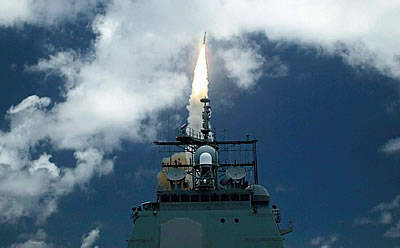
Under these conditions, the expectation of radical steps to curtail the deployment of American missile defense systems in Europe, rumors of which circulated after the new president came to power in the United States, was not justified. Half a year has passed since Barack Obama endorsed the recommendations of the Secretary of Defense and the Joint Chiefs of Staff on a phased approach to creating a European missile defense architecture by improving the potential of the US and NATO countries, optimizing it with a focus on developing proven, cost-effective technologies that can adapt to various changes in the situation.
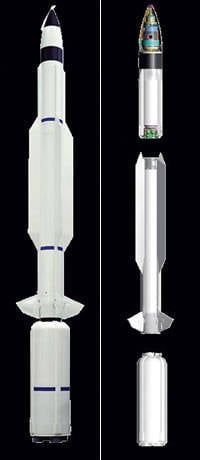 Layout SM-3 Block IA.
Layout SM-3 Block IA.Indeed, the previously proposed version of the European missile defense system with GBI antimissiles (the declared purpose of which was to protect against attacks of ballistic missiles launched from Iran) was based on technologies that still have a long development cycle, technical improvements and extremely expensive tests. This once again underlined the failure of tests that took place in January of 2010 and cost $ 200 million.
The decisions adopted in September by 2009 focus on the mobile missile defense system deployed in the Mediterranean, Baltic and Black Seas and on the territory of several European states. It will be based on the Aegis shipboard system, Standard Missile-3 anti-missiles (SM-3), as well as a number of other systems and elements, for example, the AN / TPY-2 radar used in the THAAD system.
The first stage of the deployment of this system is scheduled for 2011. The next three stages, which are expected to be completed by 2020, will include the sequential deployment of upgraded versions of anti-missile systems, command and control, radar and other means of detection. To this end, in 2010, $ 1,86 billion has been allocated to work on improving the missile defense system based on Aegis. Plans for 2011 provide for the allocation of another $ 2,2 billion for these purposes.
Aegis, which has been deployed and improved for more than three decades, is a sophisticated, intelligent, multi-functional combat system. It includes an 9-centimeter-wavelength radar (S-band) SPY-1 radar, with a range of 650 km, a fire control system, environmental message indicators, digital communication lines to coordinate on-board devices, artificial intelligence elements, and also anti-missiles SM-3, located in the vertical launch installations Мk 41.
It should be recognized that for several years already the SM-3 rocket has the status of one of the most successful developments in the United States Missile Defense Agency (MDA) arsenal. And there are several reasons for this. Among them, the developers themselves call it that the principle of test a little, learn a lot was put in the basis of the creation of SM-3, which in Russian can be rephrased as “measure seven times, one cut”.
Representing a development created back in the early 1990's. Ray-rayon SM-2 Block IV (RIM-156), the SM-3 (RIM-161) missile has the same dimensions and mass. The length of both is 6,59 m, the diameter of the accelerator is 533 mm, the diameter of the sustainer stage is 343 mm, and the mass is 1500 kg. Both missiles are equipped with the same solid-fuel boosters Мk 72 with a four-nozzle block, accelerating-marching dual-mode engines Мk 104, wings of super-low elongation and a drop-down block of aerodynamic control surfaces. Interestingly, a similar “modular” development principle was also used as the basis for the creation of the SM-6 anti-aircraft missile, capable of intercepting aerodynamic targets at distances up to 400 km.
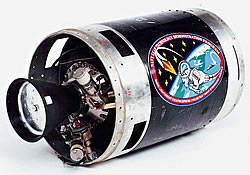 Third stage engine Mk 136.
Third stage engine Mk 136.The difference between these missiles is to install a third stage on the SM-3, which includes: the Mk 136 pre-overclocking engine, an inertial guidance section with a GPS receiver and a data exchange line, an easy drop fairing and an interception stage of the 142 X, carrying out the destruction of the target by direct hit
Mk 136 is a solid double-fueled engine, created by Alliant Techsystems based on the use of the most modern achievements in this area. It is equipped with two charges of solid fuel separated by a barrier system, and its design is made of graphite-epoxy and carbon-carbon composite materials. To ensure the stabilization and orientation of the third stage of the rocket during autonomous flight, the engine includes an integrated control system using cold gas as a working medium.
In turn, the Mk 142 is a self-guided device, on board which are IR-GOS with a cryogenic unit, several processors, a solid-fuel maneuvering and orientation unit (DACS), a power source and a number of other subsystems.
Advertising at the initial stages of work, their achievements in the development of the interception stage, Raytheon reported that the detection range of the IR-GOS target is more than 300 km, and using DACS allows its flight path to be rejected to a distance more than 3-3,2 km.
It should be noted that the creation of such a small-sized propulsion system was one of the results of the mid-1980-s that had begun. programs for the implementation of critical technologies in the field of missile defense. At that time, a number of leading American firms were connected to its implementation on a competitive basis. As a result, by the beginning of the 1990's. Boeing, which has become a leader in this work, has created the world's “lightest” (weighing less than 5 kg) propulsion control. It consists of a solid fuel gas generator equipped with several charges, a nozzle block and high-speed (up to 200 Hz) valves capable of operating at a temperature of 2040 ° С. As noted, the creation of such a design required the use of special heat-resistant materials, in particular, based on rhenium.
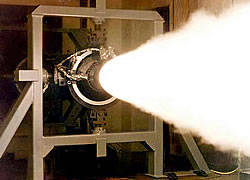 Tests of the third stage engine.
Tests of the third stage engine.Further, the Elkton branch of Alliant Techsystems carried out the work on integrating this system into a Raytheon 23-kg self-guided LEAP (Lightweight Exo-Atmospheric Projectile) level, which was used during the SM-3 tests until the middle of 2003 in A And since December of that year , with the FM-6 test, the DACS version equipped with a single solid-fuel charge began to be used as part of the Mk 142. The same DACS version was equipped with the first SM-2004 Block I anti-rocket missiles installed in 3 on the US Navy.
In general, according to E. Myashiro, one of the leaders of the Raytheon developer company, tests performed in those years confirmed that “the SM-3 rocket was designed taking into account its easy transfer from development to deployment and, if necessary, readiness for immediate action. " In turn, the leadership of MDA noted that "the work was carried out faster than expected and without failure."
Work on the further modernization of the SM-3 began even before its first launch, which took place on 24 in September of 1999 as part of the Aegis LEAP Intercept (ALI) demonstration program. The first of these was a variant of the SM-3 Block IA, which had minor improvements in the design of the interception stage. His flight tests began on 22 on June 2006, and to date, he has performed about ten successful interceptions of various ballistic targets located in different parts of the trajectory. It should be noted that in a number of these tests, along with ships of the US Navy equipped with the Aegis system, ships of Japan, Holland and Spain participated.
Reportedly, the “standard” SM-3 Block IA interception range and intercept height are 600 and 160 km, respectively, the maximum speed is 3-3,5 km / s, which provides the kinetic energy of the interception stage with a target up to 125-130 mJ. In February, 2008, after appropriate preparation, this version of the rocket was used to destroy the USA-247 satellite out of control at 193 altitude. The cost of this shooting was $ 112,4 million.
Currently, SM-3 Block IA is being mass produced, with the cost of one rocket being $ 9,5-10 million.
In the development of the next option - SM-3 Block IB - along with the US, a number of Japanese firms are involved, connected to this work in accordance with the agreement concluded in August of 1999 between the governments of the United States and Japan. Initially it was assumed that the Japanese would take part in the creation of a new stage of interception and its multicolor IK-GOS, high-performance main engine and lightweight nose fairing.
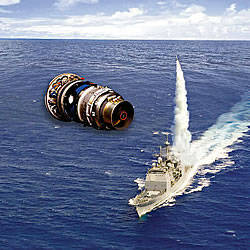 Mk 142 intercept stage - SM-3 combat projectile.
Mk 142 intercept stage - SM-3 combat projectile.However, the pace of this work was not very high. Thus, the discussion of the draft of the final version of the SM-3 Block IB took place only on July 13 2009 g. According to it, the main differences of the SM-3 Block IB from Block IA refer to the interception stage. The SM-3 Block IB will use a cheaper 10-nozzle DACS that can change the thrust, a two-color IR-GOS, allowing to increase the size of the target detection zone and improve their recognition against the background noise. It will also be equipped with reflective optics and an advanced signal processor. As noted by a number of experts, the use of these improvements will expand the range of missiles, allowing them to intercept targets at ranges greater than the previous versions.
It is expected that the first test of the SM-3 Block IB will take place at the end of 2010 - the beginning of 2011, and, upon receiving positive results, the deployment of these missiles can begin in 2013. Moreover, this option will be able to start from both ship and ground launchers, while in the system, designated Aegis Ashore ("Coastal Aegis"). The range of this option can be further increased by placing antimissiles at a considerable distance from the radar and fire control systems.
In this regard, along with the improvement of antimissiles, work is underway to adapt them for use with ground launchers. For the first time, a similar placement option for the SM-3 was proposed by Raytheon in 2003, and was further developed with the company's own funds. According to Raytheon’s management, the ground-based SM-3 test can be started in 2013, while it can be relatively easily integrated into the THAAD system. However, due to the fact that it will be “easy” and will not require making changes to the rocket design, it is not in accordance with the guidelines of the Missile Defense Agency, which was allocated $ 2010 million in 50 to study the possibility of using SM-3 as part of ground-based launchers .
In general, it is planned to manufacture X-NUMX rockets SM-2013 variants Block IА and Block IB by 147, of which 3 will be deployed as part of a missile defense system - on 133 ships in the Pacific Ocean and on 16 - in the Atlantic. The rest will be used for testing. By 11, the number of antimissiles is supposed to be brought to 2016.
At the same time, in accordance with another agreement signed between the United States and Japan in December 2004, work is underway on a radical improvement of the SM-3. The development of this variant, designated SM-3 Block IIA, began in 2006. Its main external difference will be that the rocket diameter along the entire length will be 533 mm - the maximum allowed by the vertical launch setting of the 41 Mk and, therefore, not requiring special carrier ships.
Start rocket SM-3 Block IIA.
Other distinctions of the rocket will be its equipment with an intercept of increased diameter, improved IR-GOS and more effective DACS. Also on the SM-3 Block IIA there will be a folding nose fairing and aerodynamic surfaces of reduced dimensions.
Using the SM-3 Block IIA large accelerating main engine will increase the final rocket speed on 45-60%, or up to 4.3-5,6 km / s (therefore this option is also called High Velocity - “high-speed”), and the range to 1000 km. In turn, an increase in the size of the rocket will lead to a more than one and a half increase in its starting mass.
The total cost of developing the SM-3 Block IIA can amount to $ 3,1 billion (the cost of the first missile samples is up to $ 37 million), and it can also include a number of works previously performed by the Missile Defense Agency under the MKV miniature interception program. Kinetic Vehicle), which will compete with the UKV (Unitary Kinetic Vehicle) interception stage currently being developed for the promising variants of the SM-3.
As expected, the first launch of the SM-3 Block IIA will take place in July 2014. In the case of successful tests, the operational deployment of these interceptors will begin in 2015, and the full-scale deployment in 2018.
The SM-3 Block IIB rocket plans provide for a further increase in performance due to the installation of an increased size interception (UKV) stage with higher search and target recognition characteristics, as well as the ability to maneuver vigorously at the final segment (High Divert). . For SM-3 Block IIB, the use of remote target destruction technology is also envisaged, which will include not only the launch of the missile from data from remote radars and control systems, but also the possibility of updating them during the flight from other systems.
Future plans envisage that by 2020, it will be possible to equip the SM-3 Block IIB with several MKV interception steps, the mass and dimensions of which will allow up to five such devices to be placed on board. Introducing such improvements will make it possible to treat SM-3 Block IIB as an anti-missile with noticeable capabilities for intercepting ICBMs and their warheads in extra-atmospheric sectors of the flight trajectory.
Western European defense zones with missiles (from left to right) SM-3 Block IA, SM-3 Block IB and SM-3 Block IIA.
In general, already today, the Aegis system, which has been upgraded to solve missile defense tasks, is equipped with 18 US Navy ships. In the future, it is assumed that all destroyers of the Arleigh Burke type and a significant part of the Ticonderoga-type cruisers — the entire 3 ships — will be equipped with various SM-65 variants. A decision was also made to equip a similar system of new destroyers of the Zumwalt type. The potential for additional SM-3 missiles of the Japanese Navy ships (6 units), which is currently being implemented, of South Korea (3 units), Australia (3 units), Spain (6 units) and Norway (4 units).
The “optimization” of the European missile defense system according to the American scenario opened the “second wind” for European developers, who have been working on the European missile defense system development program since May 2001. In the initial stages, they were connected to two groups of firms, led by Lockheed Martin (it included Astrium, BAE Systems, EADS-LFK, MBDA and TRW) and SAIC (its team included Boeing, Diehl EADS, QinetiQ and TNO). Moving in the same direction, in 2003, EADS announced the start of work on the Exoguard transatmospheric antimissile system, the main elements and design of which should be based on the use of European know-how, and its main objectives should be ballistic missiles with a range of 6000 km. As reported, this two-stage solid-fuel rocket with a launch mass of about 12,5 t should accelerate the kinetic interception stage to a speed of 6 km / s.
In 2005 in Europe, work began on the program Active Active Shielded TMD (ALTBMD), the purpose of which was to ensure the protection of the Armed Forces of NATO, and subsequently the civilian population from ballistic missiles with a firing range of up to 3000 km. However, for several years the pace of these works was low, until the emergence of American initiatives on "optimization". But in January, 2010, plans to create a European missile defense by the forces of European states again became the focus of attention of a number of politicians who are planning to launch discussions on this topic before the spring NATO summit in 2011, the period when the countries of the alliance have to decide on specific deployment issues in Europe new missile defense system.
SM-3 container ground launcher.
In the meantime, EADS Astrium has made a proposal to begin financing the development of Exoguard anti-missile missiles, and a group of companies comprising MBDA, Thales and Safran - creating a missile defense system based on Aster anti-missiles and the new GS1000 and GS1500 radars.
At the same time, according to the calculations of Thales and MBDA, the creation of a missile defense system designed to combat ballistic missiles with a firing range of up to 3000 km will require investments of up to 5 billion euros over the next ten years.
- Vladimir KOROVIN
- http://oborona.ru"rel =" nofollow ">http://oborona.ru
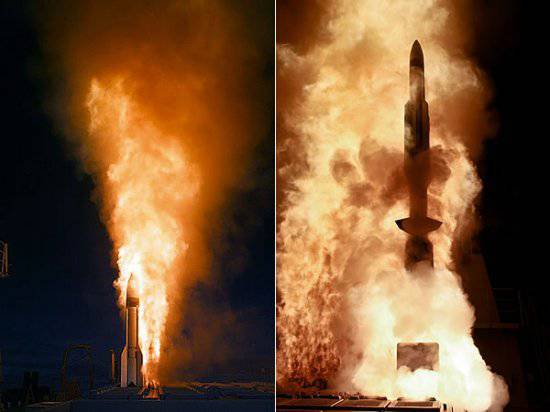

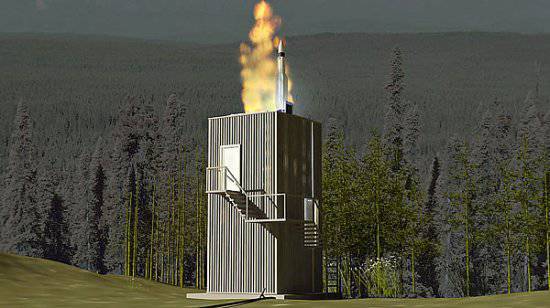
Information